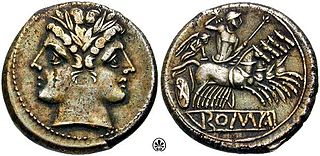
Sextans is a minor equatorial constellation which was introduced in 1687 by Johannes Hevelius. Its name is Latin for the astronomical sextant, an instrument that Hevelius made frequent use of in his observations.

Sexi, also known as Ex, was a Phoenician colony at the present-day site of Almuñécar on southeastern Spain's Mediterranean coast.

The British pre-decimal halfpenny coin, usually simply known as a ha'penny, historically occasionally also as the obol and once abbreviated ‘ob’ , was a unit of currency that equalled half of a penny or 1/480 of a pound sterling. Originally the halfpenny was minted in copper, but after 1860 it was minted in bronze. In the run-up to decimalisation it ceased to be legal tender from 31 July 1969. The halfpenny featured two different designs on its reverse during its years in circulation. From 1672 until 1936 the image of Britannia appeared on the reverse, and from 1937 onwards the image of the Golden Hind appeared. Like all British coinage, it bore the portrait of the monarch on the obverse.

The as, occasionally assarius was a bronze, and later copper, coin used during the Roman Republic and Roman Empire.

Obverse and its opposite, reverse, refer to the two flat faces of coins and some other two-sided objects, including paper money, flags, seals, medals, drawings, old master prints and other works of art, and printed fabrics. In this usage, obverse means the front face of the object and reverse means the back face. The obverse of a coin is commonly called heads, because it often depicts the head of a prominent person, and the reverse tails.

The quadrigatus was a medium-sized silver coin produced by the Roman Republic during the 3rd century BC. The obverse featured a young janiform bust and the reverse featured Victory driving a quadriga, giving the coin its Roman name, with the inscription "ROMA" below.

The semis, literally meaning half, was a small Roman bronze coin that was valued at half an as. During the Roman Republic, the semis was distinguished by an 'S' or 6 dots. Some of the coins featured a bust of Saturn on the obverse, and the prow of a ship on the reverse.

The quadrans or teruncius was a low-value Roman bronze coin worth one quarter of an as. The quadrans was issued from the beginning of cast bronze coins during the Roman Republic with three pellets representing three unciae as a mark of value. The obverse type, after some early variations, featured the bust of Hercules, while the reverse featured the prow of a galley. Coins with the same value were issued from other cities in Central Italy, using a cast process.
The bes was an Ancient Roman bronze coin produced during the Roman Republic. Valued at two thirds of an as, it was only produced in 126 BC by C. Cassius in combination with the dodrans, another very rare denomination which was valued at three quarters of an as.
Roman Republican currency refers to the Coinage struck by the various magistrates of the Roman Republic, to be used as legal tender. In modern times, the abbreviation RRC, "Roman Republican Coinage" originally the name of a reference work on the topic by Michael H. Crawford, has come to be used as an identifying tag for coins assigned a number in that work, such as RRC 367.

The Ancient Romans developed the Roman hand abacus, a portable, but less capable, base-10 version of earlier abacuses like those used by the Greeks and Babylonians. It was the first portable calculating device for engineers, merchants and presumably tax collectors. It greatly reduced the time needed to perform the basic operations of arithmetic using Roman numerals.

Sextans A is a tiny dwarf irregular galaxy. It spans about 5000 light-years across, and is located at 4.3 million light-years away, in the outskirts of the Local Group of galaxies, which includes the Milky Way galaxy, and to which Sextans A may or may not belong.
The Sextans Dwarf Spheroidal is a dwarf spheroidal galaxy that was discovered in 1990 by Mike Irwin as the 8th satellite of the Milky Way, located in the constellation of Sextans. It is also an elliptical galaxy, and displays a redshift because it is receding from the Sun at 224 km/s. The distance to the galaxy is 320,000 light-years and the diameter is 8,400 light-years along its major axis.

Sextans B is an irregular galaxy that may be part of the Local Group, or lie just beyond it. Sextans B is 4.44 million light-years away from Earth and thus is one of the most distant members of the Local Group, if it is indeed a member. It forms a pair with its neighbouring galaxy Sextans A. It is a type Ir IV-V galaxy according to the galaxy morphological classification scheme. Sextans B may also be gravitationally associated with the galaxies NGC 3109 and the Antlia Dwarf.
The dodrans or nonuncium was an Ancient Roman bronze coin produced during the Roman Republic.
Aes grave is a term in numismatics indicating bronze cast coins used in central Italy during the 3rd century BC, whose value was generally indicated by signs: I for the as, S for semis and pellets for unciae. Standard weights for the as were 272, 327, or 341 grams, depending upon the issuing authority.
The uncia was a Roman unit of length, weight, and volume. It survived as the Byzantine liquid ounce and the origin of the English inch, ounce, and fluid ounce.

Arándiga is a municipality located in the province of Zaragoza, Aragon, Spain. According to the 2004 census (INE), the municipality has a population of 472 inhabitants.
Like the Egyptians, Phoenicians and Carthaginians, the Etruscans were rather slow to adopt the invention of coinage. The brief period of Etruscan coinage, with the predominance of marks of value, seems to be an amalgam that reconciles two very different monetary systems: the 'primitive' bronze-weighing and aes grave economy of central Italy with that of struck silver and gold issues of southern Italian Greek type not familiar in Etruria.
The libral standard compares the weight of coins to the bronze as, which originally weighed one Roman pound, but decreased over time to 1/2 pound. It is often used in discussions of ancient cast coinage of central Italy, especially Etruscan coins and Roman Republican coinage. The adjective libral is related to libra, the Ancient Roman unit of weight, and is not related to the word liberal.












